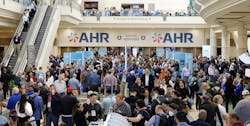Webster’s New Collegiate Dictionary, defines ventilation as, “a means or system of providing fresh air.”
With that definition in mind, it’s revealing to look at the conclusions of one of the Environmental Protection Agency’s (EPA’s) residential planning documents, which states: “Traditional heating and cooling systems in U.S. homes have not addressed the fresh air ventilation needs for home occupants. Homes experience inadequate ventilation because they rely on infiltration and natural ventilation rather than controlled mechanical ventilation systems.”
The U.S. has a long history of inadequate ventilation in homes, going back to colonial times. In fact, it was Benjamin Franklin who said, “I am certain that no air is so unwholesome as air in a closed room, that has been oft breathed and not changed.”
For many homeowners, the situation remains the same, and it’s obvious that many uninformed consumers will continue to try to mask Indoor Air Quality (IAQ) problems rather than solve them, by the way they pursue ionizers, room air fresheners, deodorizers, and scented candles. You can see why the ventilation industry is so interested in putting the V back in HVAC.
We Spend Most of Our Lives in Buildings
North Americans spend, on average, more than 90% of their time in buildings — much of it in the home. Because EPA studies have shown that indoor air contains 3 to 5 times more chemicals than outdoor air, this isn’t good news, and it certainly doesn’t bode well for the health of the people living in those homes.
Other findings, from the Energy and Environmental Buildings Association, (EEBA) point out that houses continue to experience poor air quality, moisture and mold problems, damp basements, and a growing concern for combustion safety — all items that can be addressed in whole or in part by proper ventilation.
ASHRAE 62.2
There are two signs of hope on the horizon: 1. The new American Society of Heating, Refrigeration, and Airconditioning Engineers (ASHRAE) 62.2 ventilation standard, which is in the process of being adopted by many jurisdictions. 2. Many innovative and affordable ventilation equipment options coming into the marketplace.
ASHRAE 62.2 spells out the rules contractors must follow to achieve acceptable Indoor Air Quality. It also provides the background for equipment such as ultra quiet fans, efficient heat recovery ventilators (HRVs), energy recovery ventilators (ERVs), new control strategies, and integrated systems. These are all solutions that combine ventilation with heating and cooling systems.
ASHRAE Standard 62.2 defines the roles of and minimum requirements for mechanical and natural ventilation systems, and the building envelope intended to provide acceptable IAQ in low-rise residential buildings. It provides definitions of important IAQ concepts, and criteria for air moving equipment. To view ASHRAE 62.2 in its entirety, visit www.ashrae.org.
Three Keys: Insulation, Air Tightness, Ventilation
With rising fuel costs, the U.S. needs more residential energy efficiency, and that means better insulation and more air-tight homes. Improved air tightness will help to eliminate random leakage. Include proper ventilation, and health issues will be better addressed.
The Energy Star Home program, and the Leaders in Energy Efficient Design (LEED) for Homes Program offer an optional Indoor Air Quality package or a dedicated point system, for homes designed to reduce pollutants and control moisture. Each approach conforms to the ventilation requirements found in ASHRAE 62.2
Information is Easy to Find
The HVAC industry has learned much about proper ventilation concepts over the years; enough to help it realize that equipment is just the beginning. Any IAQ or ventilation product purchase must be followed with proper installation, and regular service. It’s for that reason that manufacturers, the Home Ventilating Institute, and others are working hard to develop proper training for the HVAC industry.
| About the Home Ventilation Institute According to the American Lung Association’s website, “poor indoor air quality can cause or contribute to the development of chronic respiratory diseases.” The Home Ventilating Institute (HVI) is a nonprofit association whose mission is to raise awareness of the need for good ventilation, and serve consumers and members by advancing residential ventilation. HVI does this in a variety of ways. It certifies product performance for residential ventilating fans and air handling systems, provides consumer information, and participates in selected building code activities. Visit www.hvi.org for additional information. |
HVAC contractors interested in building their businesses, while offering solutions to existing and new customers, can find information and instruction on virtually every IAQ or ventilation topic from various industry peer groups. All of the leading HVAC associations and institutes — including HVI, Air Conditioning Contractors of America (ACCA), ASHRAE, and National Comfort Institute (NCI), have stepped up the amount of information they offer on these topics.
Information is multi-tiered, from basic introductions of IAQ, to equipment, to proper methods of installation, and control strategies. All point toward helping contractors find the perfect recipe for improving indoor air: exhausting stale, wet air, and introducing fresh, clean, filtered air.
New standards, addressed by new equipment and driven by improved consumer awareness translate into many new business opportunities. Products and training can help contractors turn opportunities into reality. You’re in the right business, at the right time, and there’s money to be made in home efficiency, insulation, and fresh air ventilation.
Tex McLeod is a principle in McLeod Associates, Toronto, Ontario, Canada. He has more than 25 years experience in housing and energy conservation. He can be reached via e-mail at [email protected].









